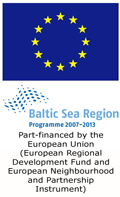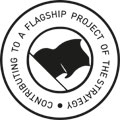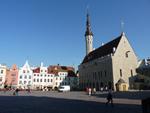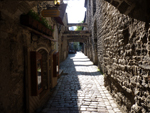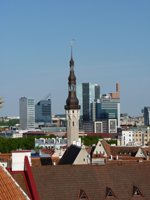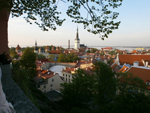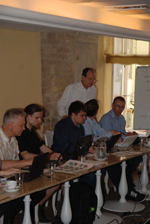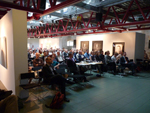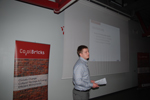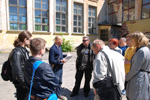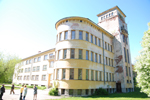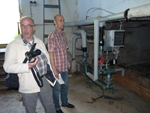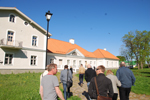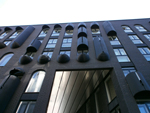21.-24.05.2012 | Tallinn and Kohtla-Järve | Estonia
Intensive Partner Meeting and Seminar in Estonia
From 21. – 24. May 2012 the project partners together with Steering Committee and Advisory Board members met in Tallinn and Kohtla-Järve in Estonia.
On the first day Mr Rainer Scheppelmann of the Hamburg Ministry of Environment and Urban Development gave a work shop for the project partners with a simulation tool for assessing the possibilities to reduce CO2-emissions in regions. Everyone got a copy of the software onto his laptop and together variations of energy efficiency activities were evaluated. For example it could be easily seen that already the change from the current energy mix for electricity to 100% renewable electricity production reduces the CO2-emissions by almost one third. A further reduction can be achieved by incremental increase of energy efficiency of household appliances, new heating systems, some rate of solar thermal hot water production and reduction of heating energy by insulating the roof, cellar and reduction of ventilation losses. The tool is called ReMAC (Regenerative Energy for Metropolitan Areas and Cities) and is available for all METREX members and for non-METREX members at a very low price.
In the evening a guided tour by the famous historian Juri Kuskemaa impressed with its detailed insights into the history of the city.
The second day saw an almost fully packed lecture hall of the Estonian Architecture Museum where the public seminar with architects and heritage specialists was held.
After the opening words by Mr. Ando Leppiman several lectures showing the high level of expertise of the speakers where held. Mr Wolfram Spehr of the architectural bureau Schwan & Spehr explained his system of wall tempering, Andra Blumberga from the Technical University of Riga and her students gave an insight to the proceedings of their research in the pilot project in Riga, Indrek Raide of Hevac company showed how the research is making progress in Tartu. Endrik Arumägi of the Technical University of Tallinn reported about the research done in the old school pilot project in Kohtla-Järve and Neeme Takis of IT-Villa held lecture about the correct application of moisture and temperature gauges and how to read the data reliably.
After the coffee break Co2olBricks dared to perform a little experiment. Dr. Rudolf Plagge, who was the next speaker, could not come to Tallinn so a Skype connection was established. With the help of an assistant in the lecture room who forwarded the slides and via laser pointer showed on the slides what Mr Plagge was talking about he explained the basic building physics of indoor insulation and how to avoid mould growth.
Very well connected to these practical insights Ms Dr. Torun Widström of the Royal Institute of Technology in Stockholm (KTH) explained how to best solve the problems of Simulation of the energy performance of historic buildings.
Jari Mikkonen, Director of Hybrid House Solutions from Finland stressed out the importance of clean indoor air and the possibilities of heat recovery in multi-storey housing renovations.
Jari Mikkonen of Hevac company rounded up by presenting the Indoor climate solutions which have been implemented at the newly opened maritime museum in the historic Seaplane Harbour in Tallinn.
The following day the project partners started early at to travel to Kohta-Järve by bus. Co2olBricks was welcomed in the mayors office by the Vice Mayor on Urban Development of Kohtla-Järve Town Ms Riina Ivanova, the Governor of Ida-Viru County Mr. Riho Breivel and the Member of the Estonian Parlament and Environmental Commission Valeri Korb.
Then the pilot project workshop on the Anton-Lembit Soans brick school building started. At first Mr. Jaan Valil of the Estonian Heritage Board explained the historical value of the building, Igor Britikovski presented the results and conclusions of the energy audit of the building and Mr NN explained the technical condition of the building.
Then a question and answers round followed where many questions were asked to the present experts, especially about financial and judicial boundaries of the project.
After this rather theoretical part all moved to the building and were divided into four working groups:
- Walls
- Windows, cellar, roof
- Heating system
- Indoor climate.
All four groups had the task to focus on their part of the building and to explore the building from outside and inside and to consider possible measures to reduce the energy consumption of the building without destroying its cultural and historic value. The groups got printed forms as in order to put down their findings.
In a plenary meeting in the stair case hall of the building each group presented their findings in a 10-minute oral presentation. A written documentation about these findings will follow.
Afterwards a visit to the polar manor house Kukruse was paid with an presentation of the lessons learnt from the problems and and achievements of restoration and maintenance of the building. The day was closed with a dinner eaten at the manor house Saka Cliff right on the cliffs facing the Baltic Sea.
The following last day consisted of an extended guided tour through Tallinn to many modern and historic examples of architecture. Amongst them was the building of the Estonian Architecture Museum, an old salt storage, the Rotermanni quarter with its mixture of modern and historic architecture, the Seaplane Harbour, the Tallinna Linnahall, a town hall from 1980 which is nowadays abandonded and looking for a new use, an old ship yard, cemetery and the wooden houses ending in Väike-Patarei 5, where the local hosting project partner SRIK has its premises with the Co2olBricks info centre.
Co2olBricks Seminar and Partner Meeting 6 - Tallinn | Estonia - 22.05.2012
- Co2olBricks project´s overview - Jan Prahm, Project Coordinator - PDF, 1.6 MB
- Wall tempering in schoolin Rehda-Wiedenbrück, Germany - Wolfram Spehr, Architect - PDF, 8.7 MB
- Results of research on 10 historical buildings in Riga, Latvia - Andra Blumberga, Technical University of Riga - PDF, 5.4 MB
- Tartu research project, Estonia - Indrek Raide, Hevac Company - PDF, 1.2 MB
- Kohtla–Järve research project, Estonia - Endrik Arumägi, Tallinn University of Technology, Estonia - PDF, 1.3 MB
- Automated measurements in building-related test-environments: Common problems and some practical solutions, Estonia - Neeme Takis, IT-Villa - PDF, 0.1 MB
- Capillary active insulation performance and usage in Nordic climate - Dr. Rudolf Plagge, Technical University Dresden, Germany - PDF, 3.7 MB
- Simulation of the energy performance of historic buildings - Torun Widström, KTH Royal Institute of Technology, Sweden - PDF, 4.6 MB
- Distributed ventilation with high efficiency heat recovery in multi-storey housing renovations - Jari Mikkonen, Director, Hybrid House solution, Finland - PDF, 1.7 MB
- Indoor climate solutions in historic buildings based on the example of Seaplane Harbour, Estonia - Teet Tark, Hevac Company - PDF, 5.2 MB
Pilot Project Workshop at Partner Meeting 6 - Kohtla-Järve | Estonia - 23.05.2012
- The heritage value of the school building - Jaan Valil, Estonian Heritage Board - PDF, 5,0 MB
- Energy audit conducted in the former school building: Results and conclusions - Igor Britikovski, Viru Energiaaudit NV company, member of the board - PDF, 0.9 MB
- Technical condition of the part of Pilot building (gym) proposed for reconstruction - Aivo Raud, Building Engineer, Zoroaster OÜ - PDF, 2.4 MB
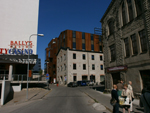
- (sources: Department for Heritage Preservation Hamburg)

